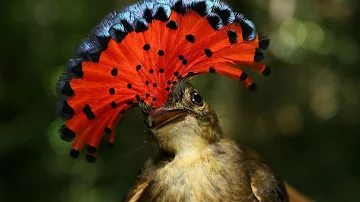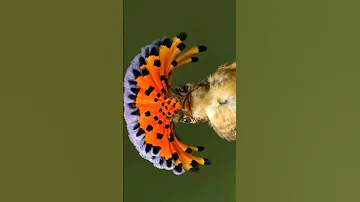
Amazonian Royal Flycatcher
Onychorhynchus coronatus

Meet the Amazonian Royal Flycatcher
The Amazonian Royal Flycatcher is a small, insectivorous bird best known for its spectacular fan-shaped crest, which is vividly colored and usually displayed during courtship or when threatened. This bird inhabits the humid lowland forests and river edges of the Amazon Basin, often remaining inconspicuous as it forages for insects. With olive-brown upperparts and yellowish underparts, its remarkable crest—red in males and yellow to orange in females—remains mostly hidden except during displays. The species builds long, hanging nests suspended over water to protect its young from predators. Despite its striking appearance, the Amazonian Royal Flycatcher is seldom seen due to its secretive habits and preference for dense forest undergrowth.
Classification
Bird
Habitat
Lowland tropical rainforest, especially near streams and rivers
Diet
Insectivore
Lifespan
5-8 years
Conservation
Least Concern
Weight
14-19 grams
📖Fascinating Facts
Crest Display
The Amazonian Royal Flycatcher's ornate crest is only raised during courtship, preening, or when the bird feels threatened, making it a rare sight even for birdwatchers.
Unique Nesting
This species constructs long, pendulous nests that can hang over a meter from tree branches, usually suspended above water to deter predators.
Habitat Specialist
It prefers humid lowland rainforests, especially riverine habitats, and is rarely found far from water sources in the Amazon Basin.
📋Detailed Description
The Amazonian Royal Flycatcher (Onychorhynchus coronatus) is a small passerine bird, measuring approximately 15–17 cm in length and weighing 14–18 grams. Its most distinctive feature is the extraordinary crest, which is erectile and fan-shaped, composed of elongated feathers tipped with vivid red in males and orange-yellow in females, bordered with blue-black. The crest is usually kept flattened and only displayed during courtship, aggressive encounters, or when startled. The plumage is generally olive-brown on the upperparts, with a rufous tail and wings, and yellowish or buff underparts. The bill is broad and flat, adapted for aerial insect capture, and is surrounded by prominent rictal bristles. The eyes are relatively large, aiding in the detection of prey in dim forest understory. This species is highly adapted to the humid lowland forests of the Amazon Basin, favoring riparian habitats and dense secondary growth. It is a solitary or loosely paired bird, often remaining motionless for long periods as it scans for flying insects. The Amazonian Royal Flycatcher is secretive and rarely vocalizes, but its soft, descending whistle can sometimes be heard in the early morning. Its nest is a remarkable structure: a long, pendulous pouch suspended from branches over water, providing protection from terrestrial predators and flooding.
💡 Did you know?
The Amazonian Royal Flycatcher's elaborate crest is so rarely seen that it was once thought to be a myth by early explorers.
🔬Research & Sources
Wikipedia Summary
The tropical royal flycatcher is a passerine bird that most taxonomic systems place in family Onychorhynchidae. It is found in Mexico, south through most of Central America, and in every mainland South American country except Argentina, Chile, Paraguay, and Uruguay.
Last Modified: 3/14/2025
🎭Behavior & Social Structure
The Amazonian Royal Flycatcher is primarily insectivorous, employing a sit-and-wait strategy from low perches, typically 1–5 meters above ground or water. It sallies out to snatch flying insects mid-air, often returning to the same perch. Prey includes flies, beetles, moths, and other small arthropods. The species is generally solitary outside of the breeding season, though pairs may be observed during nesting. It is a quiet and unobtrusive bird, moving slowly through dense vegetation and rarely joining mixed-species flocks. Territoriality is weakly expressed, with minimal aggressive interactions observed. Daily activity peaks at dawn and dusk, with foraging interspersed with long periods of inactivity. The crest is rarely displayed except during courtship, nest defense, or when handled by researchers.
👶Reproduction & Life Cycle
Breeding occurs during the rainy season, which varies regionally but typically spans from November to April in much of the Amazon. Courtship involves the dramatic raising and fanning of the crest, accompanied by fluttering flights and soft vocalizations. The female constructs the nest alone, weaving a long, narrow pouch (up to 1 meter in length) from plant fibers, moss, and spider webs, suspended over water or swampy ground. Clutch size is usually two eggs, white with brown or lilac markings. Incubation, performed solely by the female, lasts about 18–20 days. After hatching, the female continues to provide all parental care, feeding the nestlings with regurgitated insects. Fledging occurs at approximately 18–22 days post-hatch. The elaborate nest placement reduces predation risk from snakes and mammals.
🛡️Adaptations & Survival
Key adaptations include the broad, flattened bill and rictal bristles, which enhance aerial insect capture. The cryptic coloration provides camouflage in the dappled light of the forest understory. The spectacular crest, though rarely displayed, serves as a visual signal in courtship and territorial disputes, likely evolved through sexual selection. The unique nest architecture—long, pendulous, and suspended over water—minimizes predation and flooding risk. Behavioral adaptations include secretive habits, low vocalization rates, and a preference for dense, riparian vegetation, all of which reduce detection by predators.
📚Research Sources
🎨Cultural Significance
The Amazonian Royal Flycatcher is not widely featured in indigenous folklore or local mythology, likely due to its secretive nature and inconspicuous habits. However, its spectacular crest has made it a subject of interest among naturalists and birdwatchers, often featured in ornithological art and field guides. In some regions, it is considered a symbol of the hidden beauty of Amazonian biodiversity.
🔬Recent Research & Discoveries
Recent molecular phylogenetic studies have clarified the taxonomy of the Onychorhynchidae, confirming the distinctiveness of the Amazonian Royal Flycatcher from closely related taxa. Ongoing research focuses on its breeding biology, nest-site selection, and the evolutionary function of its elaborate crest. Studies utilizing bioacoustics and camera traps are helping to fill gaps in knowledge about its behavior and population density. Conservation research is increasingly concerned with the effects of habitat fragmentation and the species' resilience to environmental change.
🎥Wildlife Videos

The Amazonian Bird With a Royal Crest | Nature’s Masterpiece
Ever heard of a bird that wears a hidden crown? Meet the Amazonian Royal Flycatcher, a mysterious bird of the rainforest ...
Shark head

Amazing facts of Amazonian Royal Flycatcher | Interesting Facts | The Beast World
Amazing facts of Amazonian Royal Flycatcher | Interesting Facts | The Beast World The Amazonian Royal Flycatcher is a ...
The Beast World

Royal Flycatcher | The Exotic Royal Bird
A bird with a big personality and even cooler crest - let's take a look at the Royal Flycatcher.
Blue Orangutan

Amazonian Royal Flycatcher: Nature's Crowned Jewel
Welcome to our channel, fellow animal enthusiasts! Join us on an exciting journey deep into the heart of the Amazon rainforest as ...
Exploring Wild

Amazing Amazonian Royal Flycatcher Facts
Amazonian Royal Flycatcher—a bird of extraordinary beauty, found amidst the rich tapestry of the Amazon rainforest, Behold the ...
Knowledge Inshort

"The Amazonian Royal Flycatcher: Nature's Crowned Jewel of the Rainforest!"
WATCH SOME SHORTs
🌍Habitat Information
The Amazonian Royal Flycatcher typically inhabits Lowland tropical rainforest, especially near streams and rivers environments. Amazonian Royal Flycatchers have adapted to their environments with specialized features and behaviors.
Primary Habitat:
Lowland tropical rainforest, especially near streams and rivers
More detailed habitat information will be available soon.
🛡️Conservation Status
The Amazonian Royal Flycatcher is currently classified as Least Concern. Conservation efforts are crucial for preserving this species for future generations.
Common Threats:
- 🏠Habitat loss and fragmentation
- 🌡️Climate change impacts
- 🎯Hunting and poaching
- 🏭Human-wildlife conflict
⚠️Threats & Conservation Challenges
While currently classified as Least Concern by the IUCN, the Amazonian Royal Flycatcher faces ongoing threats from deforestation, habitat fragmentation, and hydrological changes due to dam construction and mining. Its reliance on intact riparian forests makes it vulnerable to habitat degradation. Although the species persists in secondary growth and some disturbed habitats, large-scale loss of Amazonian rainforest could lead to population declines. There is limited data on population trends, but local declines have been noted in heavily deforested regions. Climate change may also alter breeding phenology and prey availability.
🔬Scientific Classification
Scientific Name
Onychorhynchus coronatus
Classification Hierarchy
🔍 About Taxonomic Classification
Taxonomic classification is a hierarchical system used by scientists to classify and organize living organisms based on shared characteristics and evolutionary relationships.
The system moves from broad categories (Kingdom) to increasingly specific ones, with each animal's scientific name typically consisting of its Genus and species.
📝Community Notes
Share your observations and insights about the Amazonian Royal Flycatcher with our community of wildlife enthusiasts.
Join Our Community
Sign in to share your observations and connect with fellow wildlife enthusiasts.
Sign In to ContributeNo community notes yet
Be the first to share your observations about the Amazonian Royal Flycatcher!
Explore Amazonian Royal Flycatcher
Select a tab above to learn more about this amazing animal.
📸Photo Gallery
No photos available for this animal yet.
🌟Discover More Wildlife
Continue your journey of discovery with more fascinating animals from our database
